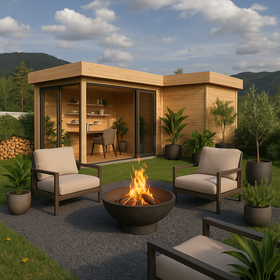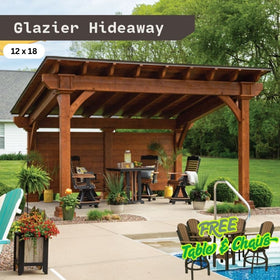512-777-0154

How Did the Tiny House Movement Start in the United States?
How did the tiny house movement start?
It began in the 1970s when Americans started questioning the need for oversized homes and endless debt. People wanted freedom, simplicity, and a lighter footprint on the planet.
Over time, that idea grew into a movement built around smart design, self-sufficiency, and a simpler way to live.
Defining the Tiny House Movement and Its Core Concept
The tiny house movement isn’t just about smaller homes. It’s a lifestyle shift. People choose to live with less so they can focus on what truly matters: time, freedom, and experiences instead of endless bills.
What Exactly Is a Tiny House? Defining the Size and Structure
A tiny house is usually under 400 to 500 square feet. Despite its size, it still packs in everything you need: a kitchen, bathroom, sleeping loft, and storage tucked into every corner.
There are two main types. Some are stationary, built on permanent foundations. Others are Tiny Houses on Wheels (THOWs), perfect for anyone craving flexibility and a home that can move wherever life leads.
Related: What Are Micro Homes? The Definitive Guide to Size, Legality, and the Tiny Living Movement
The Philosophy: What Is the Tiny House Movement About?
At its heart, the movement is about living intentionally. It challenges the idea that happiness comes from more stuff or bigger spaces. Instead, it’s rooted in minimalism, sustainability, and independence.
Many people are drawn to tiny living after realizing they don’t want their lives controlled by rent, mortgages, or clutter. It’s about creating room for what you actually love—just in less square footage.
Historical Roots and Philosophical Foundations
The tiny house movement didn’t appear out of thin air.
Its roots reach deep into American culture, shaped by thinkers and builders who believed a simple life could be a rich one.
Precursors in American Literature: Henry David Thoreau’s Walden
In the 1840s, Henry David Thoreau built a small cabin by Walden Pond in Massachusetts. He lived there for two years, focusing on simplicity, self-reliance, and reflection.
His book Walden became a timeless manifesto for simple living. Thoreau’s experiment showed that happiness didn’t depend on wealth or possessions: a belief that still inspires modern tiny homeowners today.
Early Pioneers and Architectural Explorations (1970s–1990s)
By the 1970s, Americans were rethinking what home should mean. The environmental movement and oil crises had people questioning waste and overconsumption.
Authors like Lloyd Kahn (Shelter, 1973) encouraged people to build smaller, handmade homes. Later, Sarah Susanka, author of The Not So Big House, argued that “better” could replace “bigger.”
Their ideas challenged the dream of the sprawling suburban house and helped plant the seeds for the modern tiny house revolution.
The Modern Movement Emerges in America
As the new millennium approached, a handful of builders turned this philosophy into reality. And one name stood out.
1. The American Spark: Jay Shafer and the First Tiny Home Company
In the late 1990s, Jay Shafer built a home so small it fit on a trailer, just 96 square feet. It had charm, warmth, and clever design packed into every inch.
In 1999, he founded the Tumbleweed Tiny House Company, sparking national attention. Shafer proved that small living could still be stylish, functional, and fulfilling. He didn’t just build houses. He built a movement.
2. The Economic Catalyst: The 2008 Financial Crisis
The 2008 housing collapse turned tiny homes from an interesting idea into a real solution.
As home prices and foreclosures skyrocketed, people began looking for affordable ways to live without drowning in debt.
A typical tiny house could cost between $20,000 and $50,000, compared to a traditional home priced around $270,000. The difference was life-changing. Families and individuals began trading square footage for peace of mind and financial freedom.
3. The Role of Media and Community Growth
Tiny homes soon became a national fascination. Shows like Tiny House Nation and Tiny House, Big Living brought the movement to living rooms across America.
At the same time, blogs, YouTube channels, and social media groups connected builders and dreamers. People began sharing layouts, tips, and success stories. What started as a niche idea quickly became a cultural wave, spreading far beyond the U.S.
Who Can Live in a Tiny House? Demographics and Practicalities
Tiny houses attract a surprising mix of people. Each has their own reason for going small, but they share one thing in common: a desire for freedom.
Primary Demographics: Millennials, Retirees, and the Debt-Free Seekers
Millennials see tiny homes as a way to escape rising rent and student loans. Retirees downsize to cut expenses and simplify life. And debt-free seekers of all ages use tiny living to focus on travel, hobbies, or starting fresh somewhere new.
Whether it’s a young couple working remotely or a retiree settling near the mountains, tiny living fits many different dreams.
Tiny Homes as a Solution for Affordable Housing and Homelessness
Tiny homes have also become part of the affordable housing conversation.
Across the U.S., nonprofit groups and city projects are using them to help people experiencing homelessness. These small communities offer safety, privacy, and a path toward stability.
They show that tiny homes can do more than provide comfort; they can create change.
The Trade-Offs: Space Management, Family Life, and Zoning
Living tiny takes creativity and compromise.
There’s less room for storage, privacy, and large family gatherings. Still, clever designs, like foldable tables and hidden storage, make small spaces surprisingly livable.
The bigger challenge often comes from zoning and building laws. In some cities, tiny homes are still classified as RVs or temporary structures. That’s slowly changing as more people and communities advocate for legal recognition.
How to Join the Movement: Building, Buying, and Costs
If you’re inspired to join the tiny house movement, there’s no single path. The best one depends on your budget, skills, and goals.
Options for Tiny Houses for Sale: Kits, Customs, and Used Models
- DIY kits start around $20,000 and let you build your dream home piece by piece.
- Custom designs can cost $100,000 or more, offering top-tier finishes and smart features.
- Used models are budget-friendly and often move-in ready.
Whichever route you take, the key is designing a space that reflects how you actually live, not just how it looks on Instagram.
The Ongoing Challenge of Land and Zoning Laws
The biggest obstacle isn’t building the home: it’s finding a legal place to park it.
Zoning laws differ from one area to another, and many regions still restrict small dwellings or homes on wheels.
Some cities, however, are adapting. Tiny house-friendly communities and advocacy groups are helping create spaces where owners can live legally and sustainably.
The Tiny House Movement’s Enduring Legacy
From Thoreau’s cabin by Walden Pond to Jay Shafer’s trailer home, the tiny house movement has traveled a long road. What began as a quiet rebellion has grown into a worldwide statement on how we live, spend, and dream.
It’s a reminder that a smaller space doesn’t mean a smaller life. It means living deliberately, freely, and sustainably: one tiny, meaningful step at a time.
You may also like:
- Are Tiny Homes Worth It? Breakdown of Costs, Lifestyle, and Legality
- How to Build a Tiny Home?
- Why Tiny Home? The Reasons for Buying, the History, and the Pros and Cons of Downsizing in America
- What are the Advantages and Disadvantages of Living in a Tiny House?
- What Type of Foundation is Best for Tiny Homes? Options, Costs, and Building Requirements







